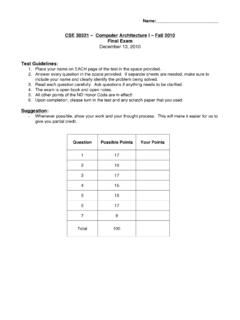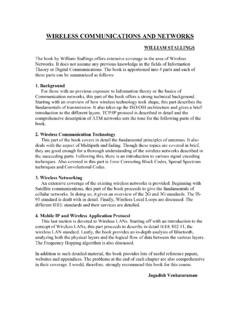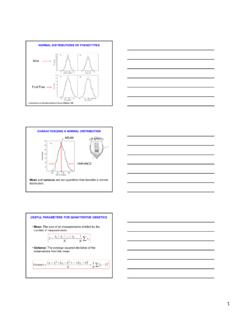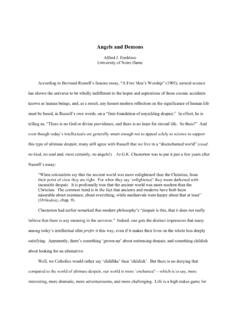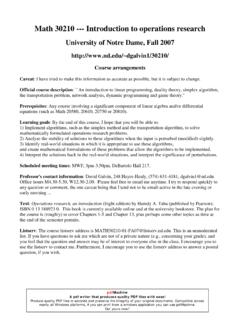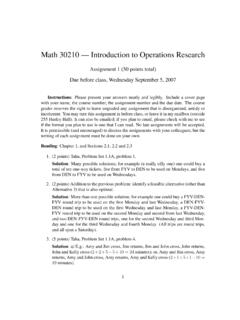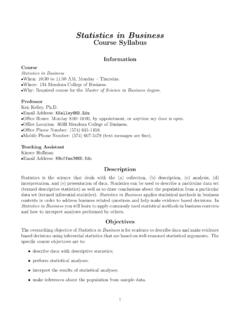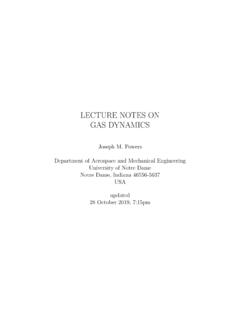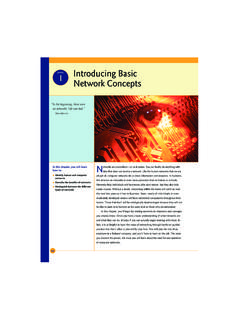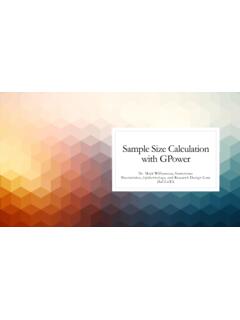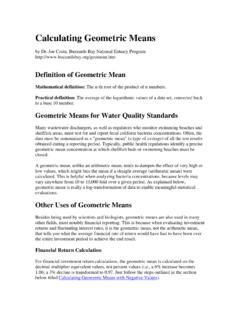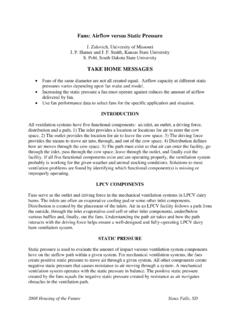Transcription of One-Way Analysis of Variance - University of Notre Dame
1 One-Way Analysis of Variance Note: Much of the math here is tedious but straightforward. We ll skim over it in class but you should be sure to ask questions if you don t understand it. I. Overview A. We have previously compared two populations, testing hypotheses of the form H0: 1 = 2HA: 1 2 But in many situations, we may be interested in more than two populations. Examples: T Compare the average income of blacks, whites, and others. T Compare the educational attainment of Catholics, Protestants, Jews. B. Q: Why not just compare pairwise - take each possible pairing, and see which are significant? A: Because by chance alone, some contrasts would be significant. For example, suppose we had 7 groups. The number of pairwise combinations is 7C2 = 21.
2 If = .05, we expect one of the differences to be significant. Therefore, you want to simultaneously investigate differences between the means of several populations. C. To do this, you use ANOVA - Analysis of Variance . ANOVA is appropriate when T You have a dependent, interval level variable T You have 2 or more populations, the independent variable is categorical. In the 2 population case, ANOVA becomes equivalent to a 2-tailed T test (2 sample tests, Case II, 's unknown but assumed equal). D. Thus, with ANOVA you test H0: 1 = 2 = 3 = .. = JHA: The means are not all equal. E. Simple 1-factor model: Suppose we want to compare the means of J different populations. We have j samples of size Nj. Any individual score can be written as follows: yij = + j + ij, where j = 1, J (# groups) and i = 1, 2.
3 , Nj That is, an observation is the sum of three components: 1. The grand mean of the combined populations. For example, the overall average income might be $15,000. One-Way Analysis of Variance - Page 1 2. A treatment effect j associated with the particular population from which the observation is taken; put another way, j is the deviation of the group mean from the overall mean. For example, suppose the average White income is $20,000. Then whites = $5,000. 3. A random error term ij. This reflects variability within each population. Not everyone in the group will have the same value. For example, the average white income might be $20,000, but some whites will make more, some will make less. (For a white who makes $18,000, ij = -2,000.)
4 F. An alternative way to write the model is yij = j + ij, where j = mean of the jth population = + j. G. We are interested in testing the hypothesis H0: 1 = 2 = 3 = .. = J But if the J means are equal, this means that j = , which means that there are no treatment effects. That is, the above hypothesis is equivalent to H0: 1 = 2 = 3 = .. = J = 0 H. Estimating the treatment effects: As usual, we use sample information to estimate the population parameters. It is pretty simple to estimate the treatment effects: y - y = NTNyyNy = y = jjjj - = , = = = ,jjjAjijN1=ijjijN1=iJ1=j Example: A firm wishes to compare four programs for training workers to perform a certain manual task. Twenty new employees are randomly assigned to the training programs, with 5 in each program.
5 At the end of the training period, a test is conducted to see how quickly trainees can perform the task. The number of times the task is performed per minute is recorded for each trainee, with the following results: One-Way Analysis of Variance - Page 2 Observation Program 1 Program 2 Program 3 Program 4 1 9 10 12 9 2 12 6 14 8 3 14 9 11 11 4 11 9 13 7 5 13 10 11 8 TAj = yij 59 44 61 43 j = TAj/Nj Estimate the treatment effects for the four programs. Solution. Note that yij = 207, so = 207/20 = Since =jj, we get 1 = - = , 2 = - = , 3 = - = , 4 = - = I. Computing the treatment effects is easy - but how do we test whether the differences in effects are significant??? Note the following: Total MS= Total DFTotal SS = 1 - N)y - y( = s = s2ij22total where SS = Sum of squares ( sum of the squared deviations from the mean), DF = degrees of freedom, and MS = Mean square.
6 Also, Between SS+ Within SS= Total SS Where Residual SS= Errors SS= Within SS= = )y - y(2ij2jij Explained SS= Between SS= N = )y y(2jjj2jij2jij= One-Way Analysis of Variance - Page 3 SS Within captures variability within each group. If all group members had the same score, SS Within would equal 0. It is also called SS Errors or SS Residual, because it reflects variability that cannot be explained by group membership. Note that there are Nj degrees of freedom associated with each individual sample, so the total number of degrees of freedom within = (Nj - 1) = N - J. SS Between captures variability between each group. If all groups had the same mean, SS Between would equal 0. The term SS Explained is also used because it reflects variability that is explained by group membership.
7 Note that there are J samples, one grand mean, hence DF Between = J - 1. We further define Variance Total = 1 - NTotal SS = 1 - NBetween SS+ Within SS = Total MS ,1 - JBetween SS = Between DFBetween SS = Between MS ,J - NWithin SS = Within DFWithin SS = Within MS Proof (Optional): Note that y - y + y - y = y - y and ,y + y - y = yjjijijjjijij We simply add and subtract yj. Why do we do this? Note that jijyy = deviation of the individual's score from the group score =ij ; and yyj = deviation of the group score from the total score = j . Hence, jij2j2ij2jij2jjij2ij2 + + = ) + ( = )y y + y y( = )y y( = Total SS Let us deal with each term in turn: Residual SS= Errors SS= Within SS= = )y - y(2ij2jij SS Within captures variability within each group.
8 If all group members had the same score, SS Within would equal 0. It is also called SS Errors or SS Residual, because it reflects variability One-Way Analysis of Variance - Page 4 that cannot be explained by group membership. Note that there are Nj degrees of freedom associated with each individual sample, so the total number of degrees of freedom within = (Nj - 1) = N - J. Explained SS= Between SS= N = )y y(2jjj2jij2jij= (The third equation is valid because all cases within a group have the same value for yj.) SS Between captures variability between each group. If all groups had the same mean, SS Between would equal 0. The term SS Explained is also used because it reflects variability that i s explained by group membership. Note that there are J samples, one grand mean, hence DF Between = J - 1.
9 0 = 0* 22 = 2 = )y y)(y y( =jjijijjjijijjjijij 2 (The latter is true because the deviations from the mean must sum to 0). Hence, Between SS+ Within SS= Total SS J. Now that we have these, what do we do with them? For hypothesis testing, e have to make certain assumptions. Recall that yij = + j + ij. ij is referred to as a "random error te or or all samples, pendent (Note that these assumptions basically mean that the are iid, independent and identically distributed); wrm""disturbance." If we assume: (1) ij - N(0, 2), (2) 2 is the same f (3) the random error terms are inde's Then, if H0 is true, 1 = E(F) and J), - N 1, - (JF~ Within MSBetween MS = F That is, if H0 is true, then the test statistic F has an F distribution with J - 1 and N - J degrees of Freedom.
10 Ix E, Table V (Hayes, pp. 935-941), for tables on the F distribution. See especially See Appendtables 5-3 (Q = .05) and 5-5 (Q = .01). One-Way Analysis of Variance - Page 5 K. Rationale: T The basic idea is to determine whether all of the variation in a set of data is attribut to chance) or whether some of the variation is attributable to chance and some is attis seen to e composed of two parts: the numerator, which is a sum of squares, and the denominator, which is the degrees om of squares can be partitioned into SS Between and SS Within, nd the total degrees of freedom can be partitioned into between and Within. nd MS ithin are determined; these represent the sample variability between the different samples and the sample var be due to random error alone, ccording to the assumptions of the one-factor model.
